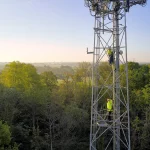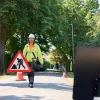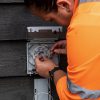Moira Stuart Helps BT Kick Off UK Digital Voice Switchover for Vulnerable Users

Broadband and phone provider BT (EE) has today launched a new campaign with Moira Stuart, a well-known British TV presenter and broadcaster, to help raise awareness around the switch to digital landlines and the forthcoming deadline of 31st January 2027 for vulnerable users.
Just to recap. The big analogue phone switch-off was last year delayed to 31st January 2027 in order to give broadband ISPs, phone, telecare providers, councils and consumers more time to adapt (details). But the main focus of this delay was the 1.8 million UK people who use vital home telecare systems in the UK (e.g. elderly, disabled, and vulnerable people), which aren’t always compatible with digital phone services (i.e. telecare providers have been slow to adapt). Take note that for everybody else, the switching deadline is still technically Dec 2025.
The industry-led shift to digital phones is being driven by two major changes, including the looming retirement of copper lines in favour of full fibre (FTTP) broadband (inc. future exchange closures) and the fact that reliability of the old network is in decline (i.e. it’s becoming harder for operators to source parts and skills for older technologies). Not to mention that it is not economically feasible to maintain both the old and new networks side-by-side long term, particularly as users of the old network dwindle.
Advertisement
Both the past and present governments have already responded to these concerns by encouraging the industry to adopt various changes (here and here), such as by ensuring that no vulnerable customers are migrated by the major providers (e.g. BT, Virgin Media, Vodafone and Sky Broadband) until their telecare systems have been confirmed to work with the new digital phone service.
Several major telecommunications providers have also launched national awareness campaigns around the switchover (National Telecare Campaign), which is where BT’s latest effort with Moira Stuart comes into play. So far “almost” 3 million BT customers across the UK have already made the switch to their IP-based Digital Voice replacement for traditional landline phones.
BT is now in the process of kicking off a new targeted regional rollout this spring, which “prioritises vulnerable customers with tailored support and in-home assistance” to ensure a smooth switch to Digital Voice. The new campaign is thus designed to reassure customers that, for most, switching to a digital landline is simple – while also helping those with additional needs, or their loved ones, understand what support is available to them and how they can make the move with confidence.
Moira Stuart said:
“Like many people, I’ve relied on a landline for most of my life – so I was curious to understand what switching to Digital Voice really means.
I’ve learned that for most of us, it’s as easy as plugging your phone into your broadband router, and you’re good to go. It’s great to see how much BT is doing to support its customers through the change – and I know first-hand how important it can be to have that extra protection against scam calls.”
The new rollout for vulnerable customers, which will be supported by “free in-home visits from engineers and battery backup units” to keep them connected during power cuts (details), is expected to start ramping up from “late-Spring“.
Advertisement
Rollout schedule for vulnerable customers:
Spring 2025: East of England, Northern Ireland, Wales, Yorkshire & Humber
Summer 2025: East Midlands, London, North East England, Scotland
Autumn 2025: North West England, South East England, South West England, West Midlands
BT said they’re working closely with local authorities, telecare providers and community organisations to “deliver the right support, in the right places, at the right time“. For those without broadband, BT said they will provide a dedicated landline service, requiring no new equipment or engineer visit. This will ensure these customers can continue using their landline in the same way they do today until 2030.
The above reflects BT and Openreach’s launch of a new Pre-Digital Phone Line (PDPL) product (aka – SOTAP for Analogue). This essentially attempts to replicate how the old phone service worked, albeit over a more modern network (i.e. it does NOT require a broadband connection to function and or require battery backup). But this is only a temporary solution and it will only be available to vulnerable and edge use cases (inc. CNI) users on existing lines (not new customers) who would otherwise “face challenges” in migrating to IP based voice solutions by the deadline.
All of BT’s customers will receive at least four weeks’ notice before any change. Those who feel they need extra support are encouraged to register via BT’s Additional Needs webform. BT has the largest quantity of phone-only customers in the UK and so their approach is the most important one, but other major ISPs and phone providers must follow a similar approach.
Mark is a professional technology writer, IT consultant and computer engineer from Dorset (England), he also founded ISPreview in 1999 and enjoys analysing the latest telecoms and broadband developments. Find me on X (Twitter), Mastodon, Facebook, BlueSky, Threads.net and Linkedin.
O2 UK and Virgin Media Launch Blue Monday Priority Rewards »






















































Seems like a reasonable idea and I suppose Stuart is seen as a trustworthy face to the older generations. Others ought to be doing the same.
My big question would be – *what* is BT going to sell to those phone-only customers? Will they provide a low speed broadband service with digital voice for the same cost as they pay now? I note Openreach has offered a 512k FTTC/FTTP service for some time.
From what I’ve seen, Landline can be ridiculously expensive, as in you can get basic broadband with a ‘landline’ for about the same if not less.
Considering how little bandwidth they would use, the cost should really be allot less.
SOTAP for analogue is the transitional product for landline only customers. As I understand it they will install something akin to a VoIP adapter at the exchange to feed landline only customers. The only thing they may have get used to dialling the full number (including the STD) even if dialling another number in the same town. That’s how BT digital voice currently works.
But as the article says, BT seems intent on putting as few people onto the “pre digital phone line” as possible, which is arguably very sensible. It also won’t be available to those who move home (especially to new builds that are FTTP only) or to new customers, and it’s ultimately just a stopgap for the next few years for those who are put onto it.
I don’t think their existing broadband/phone bundle is as cheap as phone-only, and even if it were they’d have to downplay the broadband aspect to avoid people getting the idea that they’re being sold something they don’t need. Maybe the Home Essentials social tariff gets close, but not all elderly people are eligible for that.
I still don’t understand/known what happens where I’ve got “home phone” (which claims to be line rental too, on the bill) from BT, and Broadband from Zen (FTTC).
Will I be asked to move all to one provider or the other, can I just port out my home number now to another provider (be that Zen or a SIP/VOIP service like A&A, Sipgate, etc…) and save myself about £22 a month on the BT bill by no longer having to pay BT but still able to keep the phone number for the very few people that very occasionally ring it?
So far had no info from BT other than a mention with the bills that Digital is coming and they’ll be in touch at the time, and getting the feeling I’m just throwing money away each month to BT when I could have simply moved the number away to a digital alternative long ago?
You can Port your Phone Number to New any Provider
as long as they have a Phone Service
You can Port your Phone to an ISP
or Voice Phone Provider
like Skype, except Skype is closing down
so any Provider you choose should be able to Port
your Phone Number even Vonage for example
You’re an SMPF customer, which is obviously no longer supported. My general understanding is that yes you would have to migrate your service in some form [though i think SMPF customers will be the last ones to move]. Either the phone and broadband can be bundled with one supplier [so if Zen don’t offer a voip service, you would have to move broadband and phone to someone like BT, EE or Sky], or you can port your phone number to a dedicated VOIP provider and supply/use your own ATA that can be configured to connect to the VOIP providers’ service. It may be better to ask on the ispreview forum directly [or thinkbroadband], or since BT profide your phone service, ask on their community forum, for guidance on this.
I didn’t realise you could still do separate PSTN landline and broadband contracts. Yes you should be able to port your landline number to a VoIP provider of your choice.
I’m pretty sure Zen offer a Digital Voice service, so I’d just get in touch with them
You can stay with one provider as long as they do VOIP. If there’s no FTTP available in your area, there’s SoGEA which doesn’t require a phone line and virtually the same as FTTC
Most providers like sky and zen do VOIP or internet-based phones
Well, this is most interesting as I’ve just spent half an hour on the phone to BT because we are being FORCED into DV now. The actual date was supposed to be today, but I found a way to delay for a few days as we are utterly confused here and have only received literature, no other support. We are both elderly in a village susceptible to sporadic power cuts. The village is predominantly made up of retirees like ourselves. Mobile signals indoors are absent or unreliable. We’ve not been offered anything beyond a free adaptor so that our phone can be positioned away from the hub (yes, we do have broadband). This roll out has been handled spectacularly badly. It doesn’t matter how much notice you are given if you don’t really understand the implications that a change is going to make, and if that change is going to be prejudicial to your circumstances.
Everybody in an area like this should be offered a free back up battery. And those reliant on special equipment – personal alarms, etc. – should be provided with equally effective replacements, at the very least at minimal cost. I think there are going to be some very interesting cases over the next several months where elderly and vulnerable rural people are going to suffer as a result of these ill thought out changes.
It wouldn’t be appropriate to assume that any elderly person is automatically vulnerable. There are also younger people who need the support. It is also not necessarily true that being in a rural area means that you have unreliable mains power.
Hence we see BT’s publicity campaigns and pleas to get vulnerable people registered with them. In a joined up world the energy and telecoms companies would be permitted to share those lists with each other.
As for special devices – that is a matter for the suppliers of such equipment. The telecoms industry has been publicising this changeover for years. BT itself has a facility where they can test existing equipment with digital voice, and of course the telecare industry should do their bit to replace equipment where necessary.
For the majority of people who are not vulnerable and have their mains powered cordless phone plugged into that phone line, why should BT or its customers and shareholders have to pay for all these batteries and other special addons? Their phone service will not be any less reliable than it presently is. Perhaps it’ll actually be better as it won’t be served using equipment that is well beyond its expected lifespan.
Going to be fun seeing them do this with our 4km+ exchange only line that they are refusing to upgrade to fibre.
I’d guess 4km will easily give 5meg down 1 up, that’s more than enough for VOIP. Fibre is not required to move away from analogue phone network
I’m still confused to how this works. My Grandad is 91 and has had a BT telephone for many decades (No Broadband). Will he still be able to use the phone or will he need broadband?
Yes. The actual solution will depend on a number of factors.
He may stay on a physical line to an alternative to the current exchange equipment or to a Digital Voice solution over broadband. BT’s preference will be the latter but care vulnerability issues need to be addressed.
As confirmed to Parliament
“Consumers who are landline-only customers won’t be required to take a paid broadband service from BT if they do not wish to. They will be provided with a dedicated internet connection specifically for their landline service at no extra cost.”
The solution in almost every case is to migrate to Digital Voice by supplying him with a free Smart Hub 2 into which he plugs his phone. The hub is locked to voice-only, so no broadband. In a small minority of cases Pre-Digital Phone Line (PDPL) will be available as an interim measure to enable the phone to be used as if PSTN still existed (so no hub).
He won’t need to pay for a broadband contract but they will install it just for the VOIP phone.
He will get a data connection, aka broadband, bundled with the phone service.
Please contact BT about this to make sure he has the least amount of downtime, but essentially BT will install a broadband connection without an internet service on it to deliver digital voice.
In their words: By the end of January 2027, the UK’s current phone network will be retired and upgraded from copper analogue lines to a digital service. So, if you want to keep your home phone, you’ll have to switch to Digital Voice by then.
BT customers WITHOUT broadband will be switched at the exchange using BT’s “media gateway”. Your grandad will keep his copper line until at least 2030, when the exchanges start to close, but the gateway will convert his analogue voice signal to digital. The only difference he’ll notice is that he’ll have to dial the area code for local calls from the day of the switch. He won’t need broadband but if fibre is available in his area he’ll be offered a free upgrade. From 2030, he’ll be offered a router with reduced functionality to take voice calls without any internet access.
The headline makes it seem as though they’re doing Moira’s phone first.
“a well-known English TV presenter”
As in she’s born in England or she appeared on English TV?
I watched her and I’m not in England.
I think she was a BRITISH TV presenter.
Honestly the DV system is poor.
You cannot turn of the BT 1571 (despite what BT say, it’s baked into the back end and will stay on) you can only set it to 10 rings (30 secs) Which isn’t enough time for some of the oldies to get to the phone.
This can also impact customers own answering machines from working as the BT one kicks in very early.
The digital voice adapters, a simple bit of kit to set up aren’t that great to live with.
DTMF isn’t recognised on certain handsets (connected directly to the BT EE hub it works fine)
They frequently need power cycling as they can result in no dial tone or only being able to make OR receive calls, not both.
Anyway enough of my old man moaning about “progress”
VM switched me to their version of digital voice two years ago but there is no compulsion to have 1571. I still use the same handset – one with TrueCall built in which works just as it did on the analogue line.
BT does state that their DECT adaptor may only work with phones made in the last 15 years. So they know the issues.
There is still a lack of information given regarding using any existing extension wiring, I find it really annoying. i.e if they have a corded phone in the living room and one by their bed then existing wiring can and should be used especially by this group of people.
ISPs only inform users to plug a phone into the router which is not what is required. You can UPS up the router but phones on adaptors or cradled cordless handsets really aren’t to be trusted.
Basic DIY options
Buy a BT 431 to BT 431 cable and then:
FTTC – modify the Mk4 faceplate
FTTP – button off the incoming line and change NTE5C to an Extension socket
FTTP – replace the Mk4 faceplate with a new original 5c faceplate (later ones with thin contacts) modified to isolate the line and components. (no tools or wiring needed only for the person doing the mod)
FTTC/FTTP – generic disconnect and pull back extension wiring and terminate on a new Extension socket (can be done in advance of changeover day)
It is so simple and the above options are likely to cost under £6.
If you’ve got existing extension wiring, then this is what I think you should do. Caveat: I haven’t done this myself.
Disconnect the extension wiring from the old copper line at the master socket (usually terminals 2 and 5) and tape off both the old wires as they may still carry power. Using a BT 431A male to bare wire cable (or a BT male 431A plug to BT 431A male plug patch lead and cut off one end), plug one end into the hub and connect the other to the extension leads. I’m not sure whether BT approves of this but Virgin Media does similar for free (only slight difference is that VM’s hub has an RJ11 port).
My wife and I are in our mid 70s. I pay for AAISP for my VOIP contract at a cost of £1.20 a month. AAISP VOIP is never used for outgoing calls and the only person that calls in is my sister whose husband is a BT retiree! The rest of our multi-generational family favour FaceTime.
my mother ( whose nearly 80 ) has recently had bt dv installed ie new hub and bought some of the bt essential handsets ( other ones where 10+ years old and some keys werent working ) . she is more than happy with the service. due to her age, when she renewed her contract bt organised openreach to come out ( the operator said it was part of the vulnerability service they have to do ) . he came out, set it all up and all working no issues. she doesnt get hardly any power cuts and broadband is stable at around 30mb with very few outages, so thats not an issue and gets good mobile coverage too. the calls are clearer too. appreciate not everyone has a good of an install, but good installs do happen etc
On my parents account, BT tried to combine switching to digital voice with forcibly switching the broadband from part fibre to full fibre, without my parents asking for this, needing it, or even consenting to it. The disruption of an engineer coming to switch to full fibre was completely unwanted and yet BT started sending texts about an engineer coming which confused them. The call centre said you can’t have digital voice without full fibre, which was a lie. It was only when I escalated that BT backed down. They’re on digital voice now on their existing broadband. The experience caused them a lot of unnecessary stress and the call centre was appalling, although the person who finally sorted it out – after the escalation – was good.
In BT’s defence its hard for them to know what approach to take and the call centre can only go by what is on the screen for that location.
Clearly this awareness campaign is needed but the most important thing is that those who are vulnerable or likely to be confused that they (or someone on their behalf) have notified their ISP of that fact.
BT are targeting DV in areas where copper is still present.
Where FTTP is available then naturally they want to address both.
It is not just BT, I have experienced the same with Sky (father in-law)
Sometimes the timescales can be close together. I was converted to DV on FTTC then within two months there was FTTP. BT messaged that I could upgrade and by re-contracting my speed went up and the cost went down (for now).
Why remain on copper when FTTP is available?. In my father in-law’s case (Sky) I took control, planned where everything was going to go, took them through it in case an engineer came (e.g OR CSP) and then attended on the day.
Both BT (OR) and Sky (own) installers in my experience go through a set routine to protect customers and will not proceed if there is a care device dependency.
Whether vulnerable, old or just confused I just tell people I know that they can just call me and I always recommend they have a friend or relative present on the install day.
Digital Voice – I’ve been switched over in the last month. I’m on FTTC.
Overall the quality of the audio is worse than analogue.
The BT Decor 2600 handset plugged directly in the back of the BT Smart Hub sounds as if the incoming caller is lodged inside a burlap bag (Very muted) and the two BT handsets (Another decor 2600 and a Duet) running off x 2 DECT adapters have so much interference it sounds as if its watering-time in the hot house at Kew Gardens.The upstairs handsets render audio quality way worse than analogue and worse than the audio rendered by the 10 year old RTX DECT repeaters they replaced (I’ve tried to get the repeaters to work again on DV, but it appears that BT have done something to thwart that).
And, I’ve tried to isolate the interference on the BT DECT adapters (Branded EE), but no joy there either. Whilst the BT adapters use a proprietary part of the DECT band, it must be significant that the RTX DECT units never suffered such interference though both overlap with a couple of the mobile phone bands and my home is within 300 yards of two mobile phone repeaters.
Its ridiculous that I should have to consider going back to a wired extension just to get decent audio reception.
Clearly, the BT DECT adapters are either faulty or lacking some filtering in the circuitry design.
How long have they been developing and prototyping this ? And this is the carp they come up with !
I think like actress Joan Sanderson in Fawlty towers who demanded a view of the sea from her Torquay bedroom window, I’ll be demanding a reduction in price.
You seem to have an unusual set of problems. A phone directedly connected to the hub should be crystal clear and I have never known DECT repeaters to suffer from interference.
Have you tried borrowing a DECT handset, pairing that with the hub and seeing what the audio quality is like on that?
The BT Smart Hub 2 which I have has always run hot compared with other kit.
Before Digital Voice came along I even substituted the old Openreach modem (White) plus an Asus router, and that ran Wi-Fi 6 and ran faster and way cooler than the BT Smart Hub 2.
With the introduction of DV I had to bin that workaround, so that everything is now plugged into the BT Smart Hub 2, telephones included, and at today’s room temperature of 26.8c, you could brown toast on it. With DV attached its running even hotter than it used to. I have now deployed a fan focused on the slim black container of excellence.
That may be one factor contributing to the poor audio.
The others are the proximity of the mobile masts and the fact that virtually everybody round here in this high-density housing has Wi-Fi and most have migrated to 5Ghz, so that on any day I can pick-up up to 10 different wi-fi signals and some, according to a proprietry app, are 450 meters away (Must be a block of flats),
Wi-Fi in particular is returning to the situation the days 15 years ago, when congestion and interference on the 2.4 Ghz band was so bad that I was considering running the tablet from an ethernet connection.
Roll-on full-fibre
There seems to be a resistive problem somewhere in this kit, otherwise why is the BT Smart Hub 2 doing desktop oven impersonations and I’m getting the muted audio (Note:All the cabling has been kept short and is all new).
And I’m paying near on a grand a year for this carp
Ah – Hah ! Microsoft Co-Pilot AI on query concerning the hot running of the BT Smart Hub 2, states that the BT Smart Hub 2 is noted for running hotter than other equipment, typically 41C is regarded as “Normal” for this kit. Apparently, the component producing the most heat is the wi-fi circuitry, broadband and DV consumes modest amounts of power.
And when the Wi-Fi section gets too hot, firmware-based thermal throttling kicks in leading to slower and/or stalled Wi-Fi connections, a reduction in signal strength and other issues. That’s exactly what’s happening with my BT Smart Hub 2 wi-fi connection at present . I should think that the recent addition of DV and the onset of seasonally increased room temperatures was tipped-it over the edge. And there would appear to be over-spill to downward throttling of the DV audio quality ?
Faulty design. They’ve tried to cram in too many functions and electrical kit into too small a box with inadequate cooling. So often the case with electronic goods manufacturers . . . I had one Denon DVD player that went the same way.
So, it looks as if my previous action, of trying to unload functionality from the BT Smart Hub 2 to an Asus router may be the way to go for wi-fi and may have the added benefit of improving the DV Audio quality.
In pursuit of the “Unloading funtionality” idea, I’ve already tried relegating the BT Smart Hub 2 to the role of modem only with some router functionality by using its DMZ function and connecting it to the Asus Routers WAN port. But the downside of that was that I started getting shed loads of Spam mail from sites using Daemon Mailer, and that was even though the Asus Router had good firewall functionality.
So the next option, which I haven’t yet tried, is using the Asus as a Wi-Fi access point only and switching off the wi-fi on the BT Smart Hub.Perhaps restricting connections to 5Ghz only will further improve things.
I have already tried the infeasible, i.e. splitting the incoming broadband signal between the BT Smart Hub 2 and another Open Reach modem, but it appears that the BT system is set-up to support only one piece of residential Rx/Tx kit at a time. So, I was finding that whatever of the two pieces of kit that booted-up first captured control of the broadband line and froze the other hardware out. Pity. If somebody knows of a way of splitting the broadband signal, I’d be pleased to hear
Its great this do-it-yourself Service economy – contract with a dog, pat the dog handsomely and bark yourself . . .communications, banking, utilities . . meanwhile the CEOS and board sit on their stuffed behinds and rake in the profits.
Some comments:
1. WiFi and DECT are different things, poor WiFi performance will not necessarily mean poor DECT performance.
2. An (admittedly brief) Google doesn’t give me anything (other than some AI rubbish missing valid references) which suggests that thermal throttling is an issue with the BT Smart Hub 2 – can you point me towards something describing the issue?
3. DV doesn’t place much load on the hub, except when generating the ringing voltage (which will put a fairly large load on the power supply) so DV isn’t likely to cause overheating.
4. Lots of mobile phone masts or neighbouring WiFi networks are extremely unlikely to affect the quality of a wired analogue connection direct to the hub, or via DECT extenders.
5. xDSL is designed to work between two pieces of equipment only (the head end in the exchange / cabinet and your local modem). Whilst eavesdropping might be possible, three communicating pieces of equipment on the same pair is never going to work.
6. You will still get a Smart Hub 2 with full fibre – that won’t change anything you are complaining about.
We seem to have gone from an issue with DV to a general dislike of the Smart Hub 2 and lots of irrelevant concern about WiFi. If you want to get the DV working well then I would focus on that rather than let other issues distract you.
Finally, back to my question – have you borrowed a DECT handset, paired it with the hub and tested the voice quality through it?
I know, I know, as the radio personalty Mr Terence Wogan used to say “Its all running better than the M4 bus-lane” (The modern equivalent would be high reflectance smiling, both ends) . .yeah, in the BT CEO’s dreams.
But, seriously, my enquiring mind and sensitive old age pensioner supposedly de-sensitised listening orifices seek an answer as to why the audio quality has declined so significantly and suddenly coincident with the introduction of DV, especially with the BT DV DECT units, when BT DV is supposed to be a system upgrade.
When I get a nano second I will test the proposition concerning a possible electrical overload of the BT Smart Hub 2 and consequent overheating by re-commissioning the Asus router as a Wi-Fi access point and shutting done the wi-fi-on the BT Smart Hub 2.
After having one mobile phone battery go inflationary AWOL in the last month, the last thing I need is another emerging fire risk
Stop Press:
I turned off the wi-fi on the BT Smart Hub 2 and then re-booted the hub and the desktop.
Audio on the BT Decor 2600 connected to green socket on the rear of the BT Smart Hub 2 definitely improved. However, the audio on the BT Duet and Decor 2500 upstairs remained the same, even after re-booting each BT DV DECT adapter. . same annoying background hiss and weak audio sound.
So I switched the 5Ghz wi-fi back on the BT Smart Hub (previously both the 2.4 Ghz and 5 Ghz were switched on), re-booted the hub and the desktop system and found that nothing changed i.e the audio quality on the BT Decor 2600 directly wired to the BT Smart Hub 2 stayed at the slightly improved state and the phones connected to the BT DV DECT adapters still had weak audio and slight background hiss. The BT Decor 2600 is definitely now in the “Acceptable and usuable” quality range but the other two phones are not.
Subsequent enquiries on Microsoft co-pilot AI indicated that the problems with the hiss on the phones using the BT DV DECT adapters could be down to an impedance mismatch between the old phones (12 years old) and the adapters and that some users had reported this could be alleviated by the use of passive in-line filters.
Just to be on the safe side I’ll ask BT if they could supply a replacement Smart Hub 2 as after 6 years of use it might be approaching end of life.
Without a desktop fan playing on its still running a little hotter than before DV was introduced. I think I may get one of those cooling units with dual 120mm computer fans to sit underneath the Smart hub, at least in summer. At time of writing, 22:40, its still 27.8C in this room, even with two fans running.
One extremely Customer Service friendly action BT could take is issue all customers with this problem a new BT Smart Hub 3, which, I understand, supports Wi-Fi 6 and as this generates far less heat, it may well be that the firmware controlled thermal throttling when using ethernet + wi-Fi + DV all at once, goes away.
I understand that BT is issuing the business version of BT Smart Hub 3 to new business customers and that EE previously issued some of the home versions to new EE customers.
You never know, BT Customer Service, may even pull their finger out and commission for production and issue cheapo in-line filters to eliminate the hissing caused by impedance mismatch on old BT wired handsets that are using the BT DV adapters.
The alternative, buying the correct BT DECT handset for use with a BT Smart Hub is reasonably difficult for the average consumer, the marketing being very confusing and the supply being patchy.
Obviously, BT marketeers have decided to go up the same yelloe brick road as Electric Vehicle manaufacturers i.e. nobody wants affordable, functional kit any longer, unreliable 3-tonne, £60,000, incendary bombs are what people need and want
The only clear case for this campaign is to ensure that the funds keep flowing to the marketeers and advertisement copy writers.
And as to the Moira Stuart BS, OAPs would probably get better reception holding a fossilised dog turd to their ears – signifying a regard for OAPs at least equivalent to the banks . . who expect OAPs to travel miles just to undertake the most basic transactions . . and that’s with Santander in NW suburban London . . . their remote Cheque Paying function on their mobile app, being totally useless, as I experienced this afternoon.
There seems to be a common theme here . . in addition to the usual stiff ignoring by HMG – customer service is dead, . . . long-live the board-room and shareholder income.
You can guess the entries by the “Social” worker that will be planted in the medical records . . . “Hearing issues on the telephone . . . difficulty comprehending what I’m telling them, requiring frequent repetition . . early signs of dementia . . . . recommendation for a “One-way under-bus ticket” . . . .nah, they wouldn’t do that . . . really ?
Last para 100% correct, one thing they do excell at though is customer diservice with so called responsible far from accountable management hiding behind the front line call center staff. Simply shoddy practice, and total negligence on behalf of all the Ofxxxx ‘regulators’ and of course the government oversight.
Its the “I like big corporate numbers show”
Ahh, the truth is out there, but we’re not really telling you, or facing up to it, ignorance is bliss, until it’s removed 😀